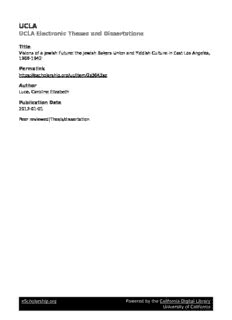
Visions of a Jewish Future: the Jewish Bakers Union and Yiddish Culture in East Los Angeles ... PDF
Preview Visions of a Jewish Future: the Jewish Bakers Union and Yiddish Culture in East Los Angeles ...
UCLA UCLA Electronic Theses and Dissertations Title Visions of a Jewish Future: the Jewish Bakers Union and Yiddish Culture in East Los Angeles, 1908-1942 Permalink https://escholarship.org/uc/item/2z3643xz Author Luce, Caroline Elizabeth Publication Date 2013 Peer reviewed|Thesis/dissertation eScholarship.org Powered by the California Digital Library University of California UNIVERSITY OF CALIFORNIA Los Angeles Visions of a Jewish Future: the Jewish Bakers Union and Yiddish Culture in East Los Angeles, 1908-1942 A dissertation submitted in partial satisfaction of the requirements for the degree Doctor of Philosophy in History By Caroline Elizabeth Luce 2013 © Copyright by Caroline Elizabeth Luce 2013 ABSTRACT OF THE DISSERTATION Visions of a Jewish Future: the Jewish Bakers Union and Yiddish Culture In East Los Angeles, 1908-1942 by Caroline Elizabeth Luce Doctor of Philosophy in History University of California, Los Angeles, 2013 Professor Eric R. Avila, Co-Chair Professor Frank Tobias Higbie, Co-Chair This dissertation explores the activism of a cohort of Eastern European Jewish immigrants who came to Los Angeles in the first decade of the twentieth century. They focused their efforts in Boyle Heights, a residential subdivision east of the Los Angeles River, where they spearheaded the creation of Yiddish-based unions, left-wing political parties, and fraternal, cultural, and educational organizations. Scholars have long assumed that the development of Yiddish life in Boyle Heights followed the same course as in Jewish communities elsewhere and referred to the neighborhood as “Los Angeles’ Lower East Side.” Using Yiddish-language newspapers, journals and biographies, this dissertation probes the neighborhood’s reputation, showing how the area’s particular geography, pattern of settlement, and unique ethno-racial diversity ii influenced the dynamics of Yiddish-based labor and community organizing in the neighborhood. The Jewish radicals who settled in Boyle Heights had been involved in revolutionary socialist and nationalist movements in Eastern Europe and in the American cities where they lived before making their way west, and sought to replicate these experiences in their new home. But in the multiethnic context of Boyle Heights, they comprised the top of the socioeconomic hierarchy, not the bottom, challenging their understanding of their class-based and ethnic identities. In their earliest efforts, these activists purposefully built an organizational and cultural life that excluded the area’s non-Jewish residents in order to cultivate a distinct ethnic community in the multiethnic neighborhood. But over the course of two decades between the end of the First World War and the beginning of the Second, they gradually expanded the scope and scale of their activities. They strayed from the platforms of the national and international bodies with which they were affiliated, and embraced the neighborhood’s multiculturalism as part of their new collective identities as American Jews. To examine the variety of structural forces, local and global developments that encouraged this transformation, I trace the history of the Jewish Bakers Union, one of several Jewish unions formed in Boyle Heights in the 1910s, showing how their attitudes and model of trade unionism shifted through the 1920s and 1930s. By highlighting the activism of the bakers and the other members of their cohort, this dissertation complicates our understandings of class formation and Americanization of Jewish immigrants in the early twentieth century. And in turn, it contributes new details to the history of labor and left-wing community organizing in iii early twentieth century Los Angeles and asserts Boyle Heights’ place in the Yiddish- speaking world. iv The dissertation of Caroline Elizabeth Luce is approved. Eric J. Sundquist David N. Myers Eric R. Avila, Committee Co-chair Frank Tobias Higbie, Committee Co-chair University of California, Los Angeles 2013 v TABLE OF CONTENTS AUTHOR’S NOTE ON YIDDISH TERMS……………………………………………….... vii LIST OF IMAGES ..…………………………………………………………………………. viii ACKNOWLEDGEMENTS …………………………………………………………………... ix VITA..………………………………………………………………………………………….... x INTRODUCTION: Yiddish Life in Boyle Heights, History and Historiography……….. 1 1. The Origins of Yiddish Public Culture on the East Side of Los Angeles ……..….. 38 2. “Koifn Broit Bloyz Mitn Union Leybel” (“Buy Bread Exclusively with the Union Label”): the Jewish Food Chain and the Jewish Bakers Union of Boyle Heights …………………………………………………………………….. 101 3. Making an American Union: the Jewish Bakers, the Great Depression, and the New Deal …………………………………………………………………... 149 4. Los Andzhelezer Yiddishkayt and the Popular Front Against Fascism……….. 196 CONCLUSION ……………………………………………………………………………… 246 BIBLIOGRAPHY ……………………………………………………………………………. 257 vi AUTHOR’S NOTE ON YIDDISH TERMS Yiddish words used in this dissertation are generally romanized according to the standards prescribed by YIVO, except when I have chosen to preserve the romanization provided by the author of the source. Accordingly some publications, including Folks Zeitung and Di Yiddishe Presse, have been romanized according to the spellings provided by the authors of the publications. The spelling of the authors’ and activists’ names honors their preferred spellings as they appear in English-language documents from the period. vii LIST OF IMAGES Chaim Shapiro upon his release from Odtiker Prison, 1905.…………………………….. 56 Arbeter Ring Picnic in Alhambra, 1920s…………………………………………………….. 73 Campus of the Jewish Consumptive Relief Association’s Sanatorium, 1920s………….. 81 Map, Population Distribution in Boyle Heights, 1920s…………………………………… 86 “The Bread Trust” from The Bakers Journal, March 13th, 1926…………………………… 112 Armenian Bakers in downtown Los Angeles, 1902……………………………………… 122 Advertisements from the California Jewish Voice, 1922 ………………………………….. 128 Mixers at an industrial baking plant, early twentieth century …………………………. 130 Members of Local 453’s executive board at the 12th Anniversary in 1936……………... 134 “Bekers Union Local 453 Apelirt tsu koifn broit und cake productn mit dem union leybel” (“Bakers Union Local 453 appeals to [you] to buy bread and cake products with the union label”), 1936………………………………………………………... 136 “Hunger Protest, October 2nd, 1933” by Harry Quillen ………………………………... 165 Logo of the Bakery and Confectionery Workers International Union, 1938 ………….. 189 Nazi Flag outside Downtown Los Angeles Businesses, 1938…………………………... 198 Class picture from the Yiddish folkschule on Soto Street, 1943………………………….. 218 Anti-Nazi Parade in Los Angeles, CA, Nov. 22nd, 1938 (three images)…………… 235-236 viii
Description: